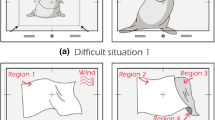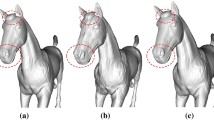Abstract
Mathematical knots are different from everyday ropes, in that they are infinitely stretchy and flexible when being deformed into their ambient isotopic. For this reason, challenges of visualization and computation arise when communicating mathematical knot’s static and changing structures during its topological deformation. In this paper, we focus on visual and computational methods to facilitate the communication of mathematical knot’ dynamics by simulating the topological deformation and capturing the critical changes during the entire simulation. To improve our visual experience, we design and exploit parallel functional units to accelerate both topological refinements in simulation phase and view selection in presentation phase. To further allow a real-time keyframe-based communication of knot deformation, we propose a fast and adaptive method to extract key moments where only critical changes occur to represent and summarize the long deformation sequence in real-time fashion. We conduct performance study and present the efficacy and efficiency of our methods.
Graphic abstract

.

















Similar content being viewed by others
References
Adams CC (2004) The knot book: an elementary introduction to the mathematical theory of knots. American Mathematical Society, Providence
Cao W, Hu P, Li H, Lin Z (2010) Canonical viewpoint selection based on distance-histogram. J Comput Aided Des Comput Gr 22(9):1515–1521
Carlen M (2010) Computation and visualization of ideal knot shapes. Tech. rep, EPFL
Cashbaugh J, Kitts C (2018) Automatic calculation of a transformation matrix between two frames. IEEE Access 6:9614–9622
Chen Y, Guan Z, Zhang R, Du X, Wang Y (2019) A survey on visualization approaches for exploring association relationships in graph data. J Vis 22(3):625–639
Colin C (1988) A system for exploring the universe of polyhedral shapes. In: Eurographics 88
Costagliola G, De Rosa M, Fish A, Fuccella V, Saleh R, Swartwood S (2016) Knotsketch: a tool for knot diagram sketching, encoding and re-generation. J Vis Lang Sentient Syst 2:16–25
Eades P (1984) A heuristic for graph drawing. Congr Numer 42:149–160
Erten C, Harding PJ, Kobourov SG, Wampler K, Yee G (2004) Exploring the computing literature using temporal graph visualization. In: Visualization and data analysis 2004, vol 5295. International Society for Optics and Photonics, pp 45–56
Garey MR, Johnson DS (1983) Crossing number is np-complete. SIAM J Algebraic Discrete Methods 4(3):312–316
Harel D, Koren Y (2000) A fast multi-scale method for drawing large graphs. In: International symposium on graph drawing. Springer, pp 183–196
Johan H, Li B, Wei Y et al (2011) 3d model alignment based on minimum projection area. Vis Comput 27(6–8):565
Kobourov SG (2012) Spring embedders and force directed graph drawing algorithms. arXiv preprint arXiv:1201.3011
Lee CH, Varshney A, Jacobs DW (2005) Mesh saliency. In: ACM transactions on graphics (TOG), vol. 24. ACM, pp 659–666
Lin J, Hui Z (2019) Visualizing mathematical knot equivalence. In: IS&T international symposium on electronic imaging 2019, Visualization and Data Analysis 2019 proceedings, VDA 2019. Society for Imaging Science and Technology
Lin J, Zhang H (2019) Visually communicating mathematical knot deformation. In: Proceedings of the 12th international symposium on visual information communication and interaction. Association for Computing Machinery, New York, NY, USA. https://doi.org/10.1145/3356422.3356438
Liu L, Silver D, Bemis K (2019) Visualizing events in time-varying scientific data. J Vis 5:1–16
Liu YJ, Fu QF, Liu Y, Fu XL (2012) 2d-line-drawing-based 3d object recognition. In: International conference on computational visual media. Springer, pp 146–153
Openmp. http://www.openmp.org/. Accessed Jan 7, 2020
Pach J, Tardos G (2002) Untangling a polygon. In: Mutzel P, Jünger M, Leipert S (eds) Graph drawing. Springer, Berlin, pp 154–161
Penrose R (1955) A generalized inverse for matrices. In: Mathematical proceedings of the Cambridge philosophical society, vol. 51. Cambridge University Press, pp 406–413
Schaefer M (2013) The graph crossing number and its variants: a survey. Electron J Combin 1000:21–22
Scharein RG (1998) Interactive topological drawing. Ph.D. thesis, Citeseer
Simon JK (1994) Energy functions for polygonal knots. J Knot Theory Ramif 3(03):299–320
Snibbe S, Anderson S, Verplank B (1998) Springs and constraints for 3d drawing. In: Proceedings of the third phantom users group workshop
Trace B (1983) On the reidemeister moves of a classical knot. In: Proceedings of the American Mathematical Society, pp 722–724
Vázquez PP, Feixas M, Sbert M, Heidrich W (2001) Viewpoint selection using viewpoint entropy. VMV 1:273–280
Vázquez PP, Sbert M (2003) Fast adaptive selection of best views. In: International conference on computational science and its applications. Springer, pp 295–305
Wu Y (1996) An md knot energy minimizing program. Department of Mathematics, University of Iowa
Zhang H, Thakur S, Hanson AJ (2007) Haptic exploration of mathematical knots. In: International symposium on visual computing. Springer, pp 745–756
Zhang H, Weng J, Jing L, Zhong Y (2012) Knotpad: visualizing and exploring knot theory with fluid reidemeister moves. IEEE Trans Vis Comput Gr 18(12):2051–2060
Zhang H, Weng J, Ruan G (2014) Visualizing 2-dimensional manifolds with curve handles in 4d. IEEE Trans Vis Comput Gr 1:1–1
Zhang H, Zhong Y, Jiang J (2016) Visualizing knots and braids with touchable 3d manipulatives. In: 2016 IEEE Pacific visualization symposium (PacificVis), pp 24–31. https://doi.org/10.1109/PACIFICVIS.2016.7465247
Acknowledgements
This work was supported in part by National Science Foundation Grant #1651581 and the 2016 ORAU’s Ralph E. Powe Junior Faculty Enhancement grant.
Author information
Authors and Affiliations
Corresponding author
Additional information
Publisher's Note
Springer Nature remains neutral with regard to jurisdictional claims in published maps and institutional affiliations.
Rights and permissions
About this article
Cite this article
Lin, J., Zhang, H. Accelerating visual communication of mathematical knot deformation. J Vis 23, 913–929 (2020). https://doi.org/10.1007/s12650-020-00663-w
Received:
Revised:
Accepted:
Published:
Issue Date:
DOI: https://doi.org/10.1007/s12650-020-00663-w




